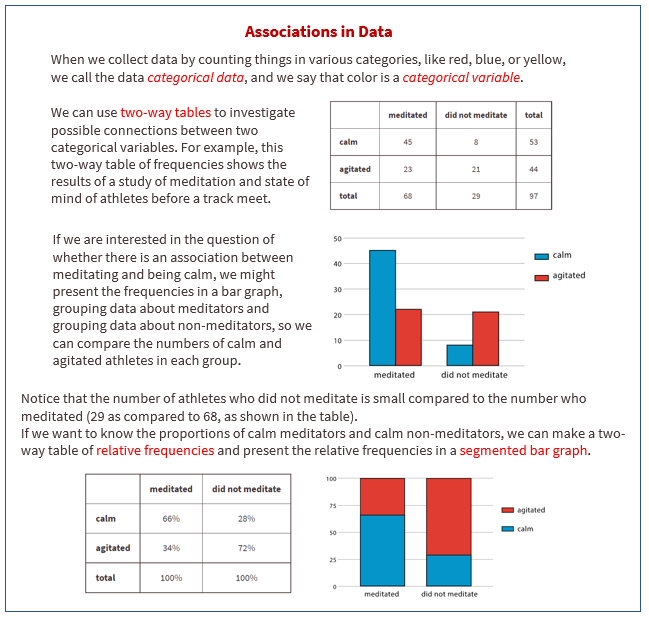Illustrative Mathematics Grade 8, Unit 6, Lesson 9: Looking for Associations
Learning Targets:
- I can identify the same data represented in a bar graph, a segmented bar graph, and a two-way table.
- I can use a two-way frequency table or relative frequency table to find associations among variables.
Related Pages
Illustrative Math
Grade 8
Lesson 9: Looking for Associations
Let’s look for associations in data.
Illustrative Math Unit 8.6, Lesson 9 (printable worksheets)
Lesson 9 Summary
The following diagram shows how use a two-way frequency table or relative frequency table to find associations among variables.

Lesson 9.1 Notice and Wonder: Bar Association
What do you notice? What do you wonder?
Lesson 9.2 Matching Representations Card Sort
Your teacher will hand out some cards.
Some cards show two-way tables like this:
Some cards show bar graphs like this:
Some cards show segmented bar graphs like this:
The bar graphs and segmented bar graphs have their labels removed.
- Put all the cards that describe the same situation in the same group.
- One of the groups does not have a two-way table. Make a two-way table for the situation described by the graphs in the group.
- Label the bar graphs and segmented bar graphs so that the categories represented by each bar are indicated.
- Describe in your own words the kind of information shown by a segmented bar graph.
Are you ready for more?
One of the segmented bar graphs is missing. Construct a segmented bar graph that matches the other representations.
Lesson 9.3 Building Another Type of Two-Way Table
Here is a two-way table that shows data about cell phone usage among children aged 10 to 18.
- Complete the table. In each row, the entries for “has cell phone” and “does not have cell phone” should have the total 100%. Round entries to the nearest percentage point.
This is still a two-way table. Instead of showing frequency, this table shows relative frequency. - Two-way tables that show relative frequencies often don’t include a “total” row at the bottom. Why?
- Is there an association between age and cell phone use? How does the two-way table of relative frequencies help to illustrate this?
Are you ready for more?
A pollster attends a rally and surveys many of the participants about whether they associate with political Party A or political Party B and whether they are for or against Proposition 3.14 going up for vote soon. The results are sorted into the table shown.
- A news station reports these results by saying, “A poll shows that about the same number of people from both parties are voting against Proposition 3.14.”
- A second news station shows this graphic.
- Are any of the news reports misleading? Explain your reasoning.
- Create a headline, graphic, and short description that more accurately represents the data in the table.
Lesson 9 Practice Problems
- A scientist wants to know if the color of the water affects how much animals drink. The average amount of water each animal drinks was recorded in milliliters for a week and then graphed. Is there evidence to suggest an association between water color and animal?
- A farmer brings his produce to the farmer’s market and records whether people buy lettuce, apples, both, or something else.
Make a table that shows the relative frequencies for each row. Use this table to decide if there is an association between buying lettuce and buying apples. - Researchers at a media company want to study news-reading habits among different age groups. They tracked print and online subscription data and made a 2-way table.
a. Create a segmented bar graph using one bar for each row of the table.
b. Is there an association between age groups and the method they use to read articles? Explain your reasoning. - Using the data in the scatter plot, what is a reasonable slope of a model that fits this data?
The Open Up Resources math curriculum is free to download from the Open Up Resources website and is also available from Illustrative Mathematics.
Try out our new and fun Fraction Concoction Game.
Add and subtract fractions to make exciting fraction concoctions following a recipe. There are four levels of difficulty: Easy, medium, hard and insane. Practice the basics of fraction addition and subtraction or challenge yourself with the insane level.

We welcome your feedback, comments and questions about this site or page. Please submit your feedback or enquiries via our Feedback page.